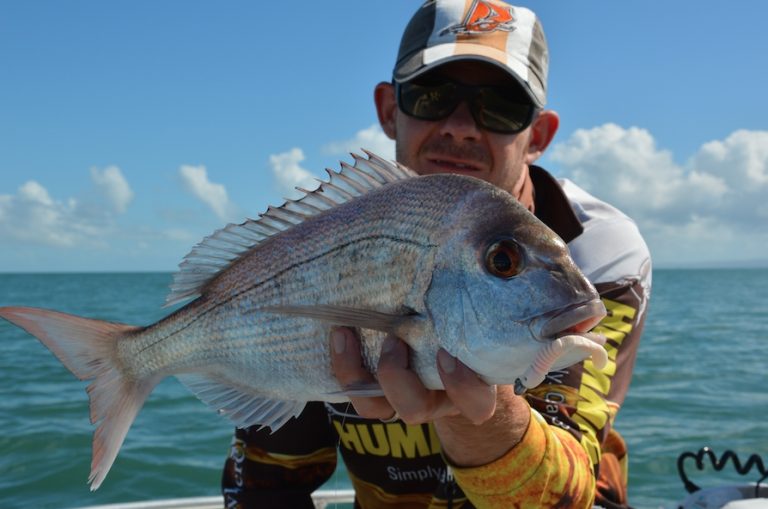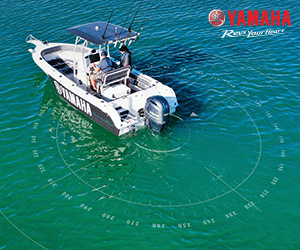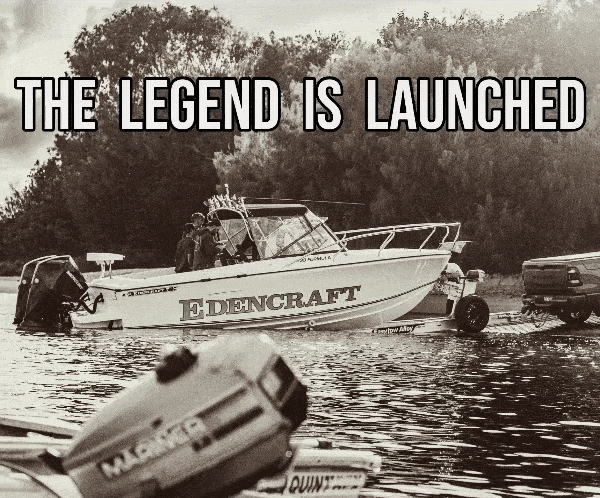Shallow action in Moreton Bay – Cody Hochen 2015
As the orange and pink haze of the sun poked its head over North Stradbroke Island, I pointed the nose of my boat across a flat Moreton Bay. My aim for this beautiful summer’s morning was to take advantage of the cloudy conditions and a large morning high tide to have some fun around the reefy shallows of some of Moreton Bays many islands.
As I approached the reef edge I stopped my Yamaha and deployed my Minn Kota. As my boat glided up into the reef shallows I grabbed my light spin stick and pressed the rabbit button on my remote. The flicker of nervous bait, followed by the slurp of its pursuer 30 metres to the left, was a sure sign that my target species was in the vicinity. I cast my three-inch baitfish profile soft plastic towards the commotion. The lure hit the water with a small splash. I aggressively lifted the rod and wound up the slack while letting it sink for 4 seconds. All of a sudden the line went tight as the lure wafted towards the bottom. I immediately struck, which resulted in my G-Loomis DSR 4-8lb folding over and braid instantly being ripped from my Daiwa Certate 2500. About 7-8 metres of 8lb braid disappeared before I could get a turn on my reel. This was followed by familiar headshakes that indicated my target species was slugging it away on the end of my line. After a few more headshakes and some darting runs near the boat, 53cm of snapper glided into the waiting net. The 1/8th jig head was set perfectly in the corner of the mouth, well away from the large bream-like teeth that could have easily chewed through my 10lb leader. The iridescent blue spots matched with its pink body, glistened in the early morning light. What a start to the morning!
Throughout the morning high tide, the bite continued with an array of species making it over the side of the Quintrex. Between two of us we caught 5 pan size snapper between 42cm to 53cm, as well as 10 grassy sweetlip and spangled emperor up to 40cm, a couple of nice size gold-spot estuary cod up to 50cm, a small rat kingfish and a few smokings into the reef. This was all in less than 8 foot of water over two of the fringing island reefs of Moreton Bay.
Fishing for snapper in the shallows reefs around the islands is my favourite style of fishing in Moreton Bay. It is a very active, effective and fun method to catch them. These super shallow waters surprisingly hold some quality fish. I have experienced some fantastic action in the shallows and often see snapper smashing bait (like pelagics) off the surface.
This type of fishing can be regularly enjoyed on the shallow reefs around the Moreton Bay islands at any time of the year. For many years people have thought snapper are an option only in winter, but with the right conditions and gear they can be caught in the middle of summer as well, especially in the shallows. When I am talking about shallows, this means less than 8 foot; not your usual snapper haunts. Snapper over 70cm are not common, but there are still plenty of 40 – 60cm snapper and other species on offer for those who put in the time.
The majority of the islands in northern and southern Moreton Bay contain fringing reef and rock, which all hold some great fish, including snapper. Although it has taken some exploring and research on Google Maps, I have located many spots throughout the bay and caught fish from the majority of these. Care must be taken when exploring the Moreton Bay islands, as some areas Marine Park Green Zones and hence, no fishing is allowed.
There are 5 key methods when it comes to consistently catching snapper in the shallows. Due to the clear, shallow water the fish are very flighty, so it is important that you use the below steps to be successful.
Conditions
First light is the most productive time to catch these flighty shallow waster fish. Once the sun has risen above North Stradbroke Island, they can become harder to find and tend to move into the deeper water surrounding the reef. I have caught fish in the middle of the day in bright sunshine but to catch consistent numbers throughout the day, there must be cloud cover – the thicker the better. Rain is certainly no excuse, as it’s usually worth the discomfort. However, like most fisherman, I usually can’t drop everything when the conditions are perfect, so I go out whenever I can. If I am lucky enough to pick a drizzly day with 5-10 knots of wind, I am confident that it will make for an outstanding day of fishing.
Tide
Tides are a huge part of being successful in all shallow water flats fishing. To catch snapper in the shallows of Moreton Bay I only fish an hour before the top of the tide and a couple of hours after the run-out tide. On a low tide these flats almost entirely drain out to 2 – 3 feet and usually don’t hold fish. On the last half of the run-in, bait from the surrounding deep water makes its way into the shallows. This in turn brings in the predators.
The size of the high tide also makes a difference. Tides larger than 2 metres are much more productive when fishing the shallows. A larger tide tends to bring in more bait and produces more currents and ambush points around the reef and rocks.
Stealth
As explained before, these fish are very flighty. Being as sneaky as possible will allow you to catch more fish. Stopping the motor before you get into the shallows, avoiding lots of boat traffic, using an electric motor or drifting, and avoiding loud noises in the boat, will improve your chances. Most people fish on the reef edge and don’t venture up into the shallows, therefore, most of the time you will have the area to yourself.
Tackle
Using the right gear is a huge part of successfully catching quality snapper in the shallows. It is important to fish light, but not too light as there are some big fish that venture up into the shallows and they certainly know how to use the reef to their advantage.
For a trip up in the shallows I will have 4 rods rigged up, 3 spin outfits with 3–4 inch soft plastics and a baitcaster rigged up with a hard vibe. These will consist of two 2500 spin reels with 8lb line and 10–12lb leader, matched with a light to medium rods around 4-10lb. These two combos will be used the most and will handle a 40–70cm snapper without too many dramas. The third spin outfit consists of 12lb braid and 20lb leader and a rod with a bit more pulling power. I am a big fan of the G-loomis GL2 in 6-12lb as this rod punches well above its weight. This outfit is used to try to stop the 70cm + snapper, 50cm + sweetlip, 60cm + estuary cod, large parrot fish and even big kingfish that make their way up into the shallows looking for an easy meal during high tide. With such reefy shallow territory, sometimes it is just impossible to stop the larger fish busting you off.
Whilst fishing the shallows, main line isn’t as important as leader size and length. Two metres of a good tough fluorocarbon leader is needed. I use Sunline FC Rock as it seems very durable when fishing hard structure. When the water is crystal clear, as is often the case in winter, the fish are very finicky and so a longer 6-8lb leader is sometimes needed to get the bite.
There are a number of soft plastics that can be used for fishing the reef shallows around the Moreton Bay islands. Anything that mimics a small baitfish around 3–4 inches will be effective. Delalande meeki, sandra and skeletons, Atomic sliders, Z-man minnowz – all in natural colours will produce. I have also had great success with yellow coloured soft plastics. I’m not sure the reason, but snapper and sweetlip seem to like this colour. When it comes to jig head size, I use 1/8th with a strong as possible hook. Compared with a 1/6th jig head, I find that a 1/8th allows the soft plastic to waft slowly enough to the bottom, yet not giveaway the lack of hook strength a 1/12th has. A large snapper is a powerful fish and will crush and straighten a light gauge hook with ease.
Technique
Fishing the shallow reefs around Moreton Bay involves more than casting and bouncing your soft plastic along the bottom back to the boat. As already suggested, the fish are finicky, so they are going to spook very easily. Casting at least 20 metres from the boat is going to catch more fish than casting 10 metres. This is the advantage of using light 8 – 10lb braid when using 1/8th jig heads, as it casts much further than heavier braid. When fishing the shallows I find more success when the wind is blowing at 5-10 knots. Casting with the wind and towards the direction of your drift will allow for longer casting. This should allow your lure to waft more naturally in the water and therefore get more bites.
When the lure hits the water, let it sink for 4-5 seconds or just before it reaches the bottom and the inevitable snagging on the reef. To get the attention of any predator that is close, use an aggressive ‘hop/retrieve’ action. After a couple of trips in the shallows, I worked out that 90% of the hits came within the first 5 hops of the lure. I think this comes down to two things: the fish within 10 metres of the boat have been spooked, and the splash of the landing lure attracts fish in shallow water. After the first 5 hops, I crank the lure back to the boat and repeat the process. This allows me to cover more ground and find the schools of snapper that move around in the shallows.
Often in the morning when I arrive at my chosen destination, it is still dark. Even though in the dark I can hear fish chasing bait up in the shallows, for some reason I haven’t had much success with using soft plastics. This is why I have a hard rattling vibe rigged onto my bait caster, such as a Jackall TN60 or a Shads vibe. This outfit involves casting the vibe out as far as possible while letting it sink for 2- 3 seconds and then aggressively bouncing/ripping it back to the boat. There is a fine line between having the lure hit the bottom and getting it snagged – so it may take a while to get the feel for this technique. This technique is used when bass aren’t in the mood to feed and catch on conventional lures. Switched on anglers use a rattling hard vibe to trigger a reaction strike. In this situation an aggressive rattling vibe seems to trigger a bite from a snapper that is struggling to see or hear a lightly weighted soft plastic in the dark. A bait caster rigged with 15-20lb braid and 20lb leader will do the trick since line and leader don’t matter so much in the dark.
Although snapper can be caught in a lot of places in Moreton Bay, there is nothing more I enjoy than catch them in super shallow water. Although most are between 40cm – 60cm, they are much more challenging to catch and land in 6 foot of water when sharp coral and rock are surrounding you. I also find they are much tastier than the large snapper and can easily be baked whole. Fishing the shallow reefs is not unique to Moreton Bay. This same technique with a bit of tinkering can be used on any fringing reef and island up the Queensland coastline. By upgrading to a 15lb line and 20lb leader with 4 – 6 inch soft plastics, I have caught some very nice coral trout around the many fringing reefs and Coffee Rock at Weipa. This would also be very successful throughout the Whitsundays as well as anywhere throughout the Great Barrier Reef.





